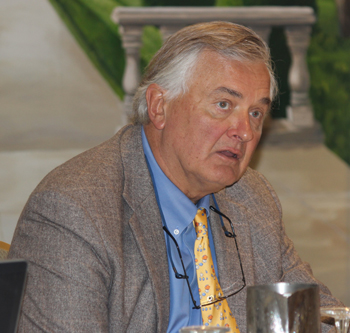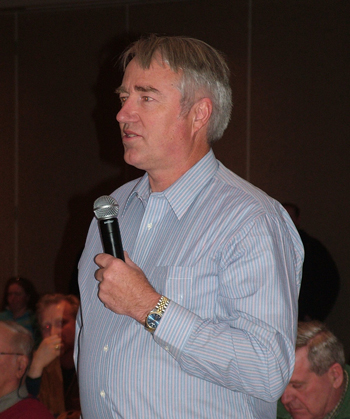Localized Herring Depletion
continued from March 2016 Homepage

John Bullard, NOAA.”We still know there’s a problem….Maybe we ought to say there’s a problem, and what’s the answer?” Fishermen’s Voice file photo
According to a summary of comments made available by NEFMC, commenters commonly said that declines in the herring resource have negative impacts on other species that rely on herring as prey, and in turn, the associated industries that rely on predators, such as tuna, groundfish, and whale-watching.
Comments included:
“...without herring, we don’t really have a fishery. It goes hand in hand with every other fishery – groundfish, stripers, and the recreational guys.”
“...the nation has lost out on a $35 million a year commercial bluefin tuna industry; these highly migratory fish now pass along our shoreline and summer over in Canadian waters due to the lack of the abundance of very nutritious Atlantic sea herring in American waters!”
Commenters most commonly cited concerns about current regulations that allow for concentrations of fishing effort by mobile gear, primarily midwater trawls, on herring in certain times and locations. They said they were concerned that the fleet has been causing localized herring depletion, particularly of the inshore resource.
Commenters presented a number of examples to NEFMC on ways to remediate the problem. They included:
• a year-round inshore buffer area in herring management Area 1A
• a 12-mile inshore buffer year-round south of herring management Area 1A year
• a 35-mile inshore buffer year-round south of herring management Area 1A
• a year-round purse-seine-only area with a 50-mile inshore buffer south of 1A
• year-round closure of certain areas.
At their January meeting, NEFMC members discussed whether the matter was really about localized depletion or more about conflict between user groups.
“I’ve been hopeful we’ll use science to take this issue apart,” said NEFMC member Jeff Kaelin. “These have to be science-based considerations….We have to have decisions based on fact and not based on what he said or she thinks.”
National Marine Fisheries Service (NMFS) chief John Bullard said that, no matter what the definition of localized depletion is, “we still know there’s a problem….Maybe we ought to say there’s a problem, and what’s the answer? Should we build some lines, and say that some people should be in these lines and some shouldn’t?”
NEFMC member Terry Alexander said the concept of localized depletion is debatable, because herring is a migratory species.
“The fishing industry goes where the fish are,” Alexander said. “You can force us into a box. But if we put a 12-mile line in and then shut down Georges Bank, where’s the fleet going to fish? That’s what I worry about.” The lobster fishery is highly dependent on the herring fishery for bait, Alexander noted. “So it makes me nervous.”
“Let’s not minimize those hundreds of comments,” said Chris Weiner, a tuna fisherman from Portland, and member of CHOIR and the American Bluefine Tuna Association. “They’re not Joe Blow from Arkansas. They’re real guys, and they represent a lot more people than on those lists.” Whether it’s called localized depletion or user conflict, Weiner said, “It’s when I go fishing in a place and someone knocks the herring out of the area and I can’t fish there anymore—that’s the issue.”
“We do have localized depletion, and have for a long, long time,” said Maine fisherman Glen Robbins, who runs a seiner. Midwater trawlers, said Robbins, “disrupt the herring group as a body….The trawlers have to go from the Gulf of Maine completely….I don’t want to push these guys out of business, just change them to seines.”
But another speaker said seine vessels do more damage than trawlers.
“You set that seine around a bunch of fish, and you kill that whole bunch of fish,” he said, adding that, by contrast, a midwater trawl runs once or twice through a school of herring, taking only a portion.

Glen Robbins, Herring Seine fisherman, F/V Western Sea. “We do have localized depletion and have for a long time. Midwater trawler disrupt the herring as a body.”Fishermen’s Voice file photo
Patrick Paquette, a recreational fishing advocate from Massachusetts, said localized depletion is forcing the lucrative sportfishery from eastern Massachusetts. “There’s a sewer left behind when these guys [midwater trawlers] come through our area,” Paquette said. “Our businesses are affected and our tackles sales go down and our communities are affected.”
In the end, NEFMC voted to pursue a variety of alternatives to address the issue through Amendment 8. All were potential area closures that would limit when and how close to shore midwater trawl vessels could operate.
NEFMC also voted to review giving the herring midwater trawl fishery on Georges Bank a 50 percent buffer on their 1 percent cap of GB haddock, while still retaining the 1 percent cap.
And NEFMC voted to ask NMFS to include portside monitoring of river herring/shad catch to determine that catch relative to the bycatch caps. Up to now, river herring/shad bycatch in the herring fishery is monitored by NMFS solely from observer data.
